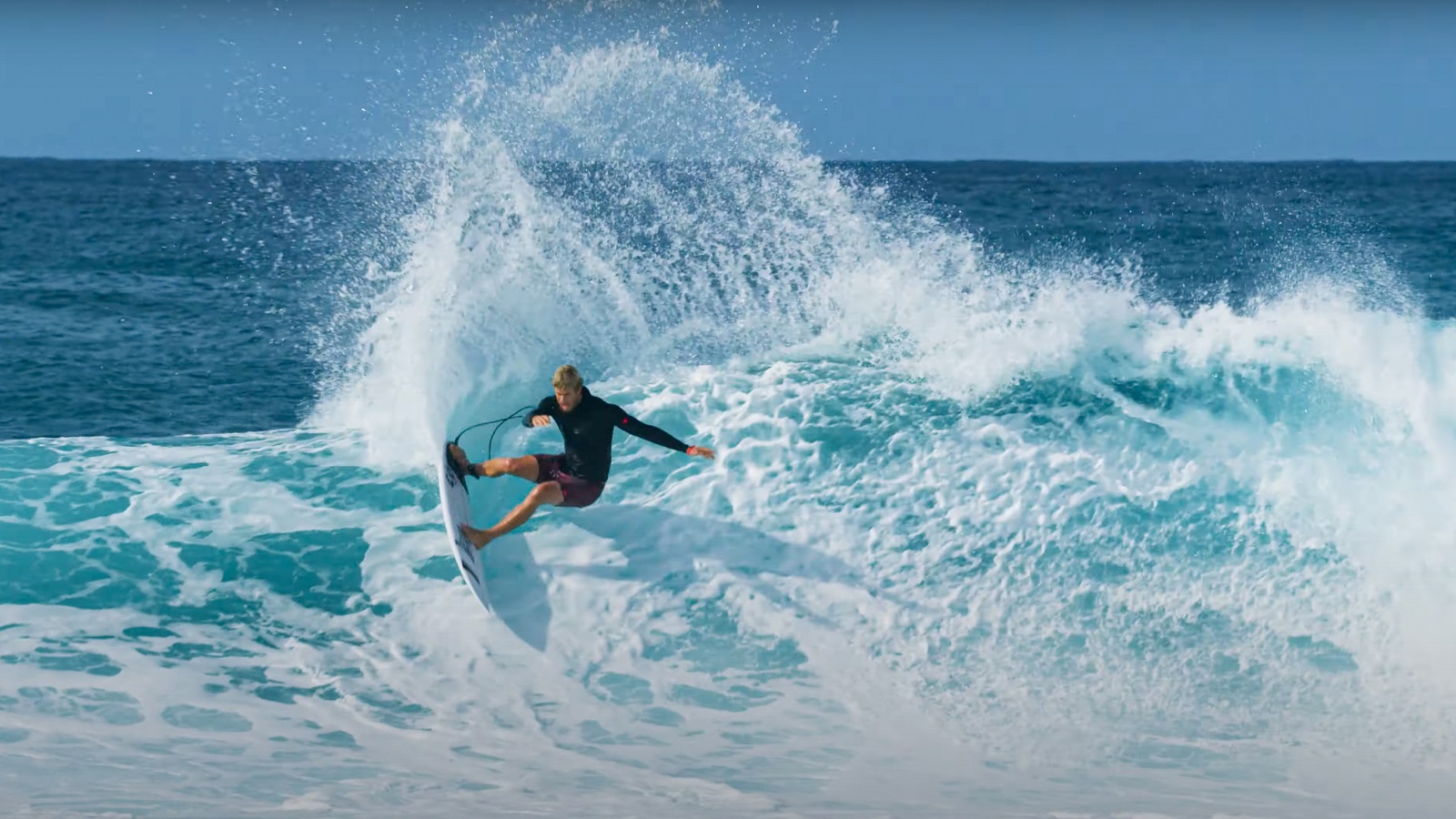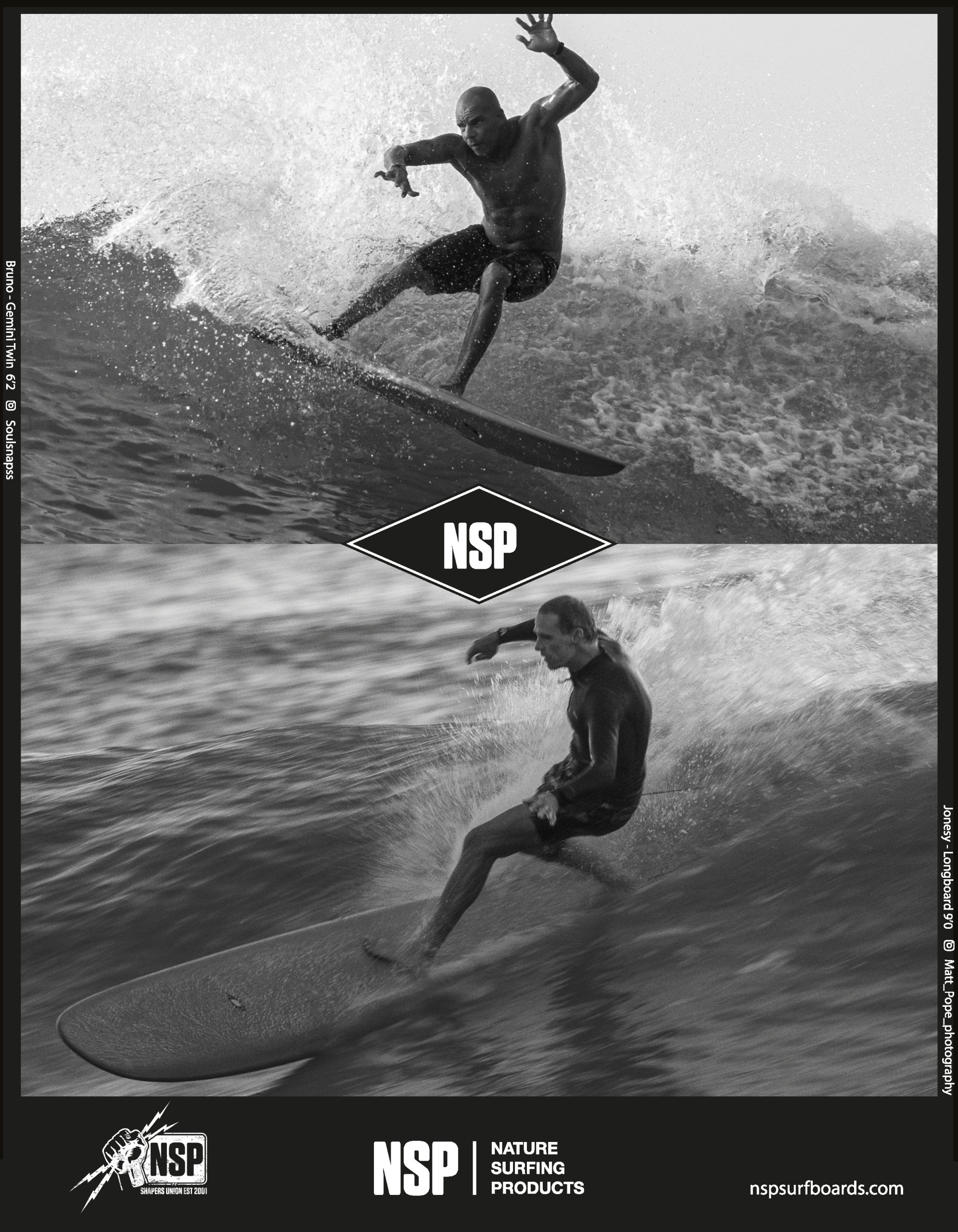2024 Surfboards Retail Buyer’s Guide
The very nature of the surfboard market means it has been relatively spared from the overstock issues reported in other boardsport categories. Add an ongoing “easy to ride” approach in 2024 and it is more likely we see even more participants joining the party. By David Bianic
The surfboard isn’t an industry per se. It’s a galaxy of master craftsmen who, together, form a market big enough to be considered an industry. Very few surfboard labels operate on an industrial scale, producing standardized goods. The surfboard business relies largely on custom-made products and on demand manufacturing.
Yet, surfboards aren’t essential products either, and the figures took a hit, the post-Covid frenzy ended with a hangover. But for Johnny Cabianca, owner of Cabianca Surfboards, the market is only going back to normal, “the way it was before the pandemic”. According to Benoit Jean, Wholesale and B2C Manager for UWL & Cardinal Surfboards in France, the customers are taking additional time to finalize their orders, but the average purchase value has increased, estimated at €1,050 for a custom board plus accessories.
Not all boards are treated equal reports Andy Wirtz from Norden Surfboard, as “there is still a lot of overstock on softboards and composite boards made in Asia”. There comes reputation, as the long-established names are doing better than the rest of the bunch. No surprise, people want “surfboard models they can trust because they have proven feedback and a reputable brand behind them”, insists Jaime Azpiroz, Product and Sales Manager for Olatu, Europe’s manufacturer for Pukas, Lost, Channel Islands, McTavish and so on. “Customers want to put money in trustworthy assets.”
2024 TRENDING DESIGNS
1 – Mids
Unsurprisingly, the mid–length/twin-fin combo should account for a large part of your inventory in 2024, much like the 3 previous seasons. Maybe the most striking piece of news here, showing the widespread adoption of the design is “Kelly Slater releasing his first ever performance mid–length, the Boss Up by Dan Mann, sized from 6’6 to 7’6”, reveals Chris Grow, Director of Brand & Marketing for Firewire Surfboards and Slater Designs.
And indeed the offer ever widens: brands started with a single “mid”, now they implement a full-on mid–length range. After its Mid Strength, Chilli releases a Full Strength, a more performance–oriented mid, “inspired by James’ [Cheal, founder] journey to the Mentawai Islands, Indonesia, with his son”.The result is a pulled nose to decrease the drag up front, together with a narrower tail area, “giving it more of a shortboard feel”. It’s the same program with the Channel Islands M23, a tested and trusted model that Al Merrick designed by for himself decades ago, which got a second wind thanks to the mid–length hype. Available in Torq’s X-Lite Construction, a technology used only on CI’s models.Also in the Torq range, the V+ (for “Volume Plus) stands somewhat in that family, an updated mini-mal’ of sorts: “The high volume makes it super easy to catch waves while the rocker and bottom contours make this lively and agile underfoot with more performance than you would expect from a larger board”, says Sebastian Wenzel, General Manager.
Stewart Surfboards always had a strong midlength game, way before we actually labeled those “hype funboards” (haters gonna hate!) as “mids”. Models such as the 949 Comp and the Funline 11 are joined by the new Wild Bill, “the ultimate high-performance mid-length surfboard”. The Wild Bill is more in tune with the latest mid designs and sports a striking simple to double concave, as well as Stewart’s iconic bevelled rails, which “allow for more foam where you need it while having a nice thin rail to carve into those turns”. Though they don’t belong to the modern mid–length design, the coupleof Pipeliners from Lightning Bolt will definitely appeal to the same grey-haired surfers. The Gerry Lopez and Rory Russell Pipeliners are true replicas of their iconic boards from the 70’s, “handcrafted using the original templates, rockers and the same glassing techniques” for the Lopez model, and with a more contemporary Eco-Tech construction for Russell’s.
Finally, Town & Country’s Missing Link is – as the name suggests – an hybridization of the shortboard step-up design and of a mid–length, meant to be ridden as a twin-fin. The Mid trend still holds a lot of potential and will carry on, says Andy at Norden, fiddling with “different fin set ups, different bottoms, channels not channels, different constructions, there is endless options”.
2 – Twinnies
As per twin-fins, the choice is even larger, from the classic retro-fish to the more progressive perf’ twins with a trailer fin. NSP covers all the spectrum of twins, spread into 3 constructions. TheirDouble Vision (PU) is a timeless option, a twin-keel fish with a retro vibe but a thinned-out design for more drive and speed. Town & Country Surf Designs really gained momentum with their modern spin-off of the Sinner and Saint shaped by Glenn Pang. The new Nomad shares some DNA with those models, now with a round-pin “thumb tail” and soft wings. The board is clearly meant for steeper faces and control in the pocket.
We also see a trend consisting in variations of a thruster model turned into a twin-fin, like the Candy model at Cabianca Surfboards, also available as a Candy Twin. On that note, Johnny Cabianca reports the have “sold less twins in the past couple of months than the years before, but more easilyshortboards”.
But feel sure, high performance twinnies are not going anywhere according to Chilli, as they display serious assets: good hold, drive, and fast directional changes, putting into light their Peppa Twin, “a go-to board for all types of waves when you’re after the speed and flow of a twin, yet the hold and performance of a thruster. Combining two perfect worlds”. Same vibe with Rusty’s Deuce (a collaboration between Rusty Preisendorfer and Noel Salas of Surf ‘n Show), as Craig Butcher (distributor via SARL Hurricane Surf) noted a shift in the twin trend : “Whereas the best-selling twin fins in the past have been with fish or hybrid style boards, the trend here seems to be getting the twin fin feel on a high performance shortboard shape.”
3 – High-Performance Shortboards
On an international level, some big names pulled out of the CT, distancing themselves from the WSL. On a regional scale, “the big brands that used to organize the competitions no longer have the means to do so. That’s why the tour in Europe has become much smaller…” regrets Johnny Cabianca. Did this affect the sales of high-performance boards? “As far as the sales of high-performance surfboards go it continues steady and has not slumped”, comments Nick Urrichio, owner and shaper of SementeSurfboards in Portugal, who made its bread and butter with these sharp blades. If we were to name thelatest trend in HPSB (high-performance shortboards), it would then be the slightly longer designs, as pointed out by Benoit at UWL, “ranging from 6’1″ to 6’4″, inspired by surfers like Harry Bryant who favour the 90’s style Australian shortboards”. And “high-perf” doesn’t necessarily translates by “exclusive”, as Rusty’s new Keg is said to be “the most approachable pro model for everyday surfers in general”, claims Surfline. Designed by Rusty Preisendorfer and Wade Carmichael, it features a high nose and tail rocker with a fairly deep concave through the bottom deck. Likely to be a staple in Rusty’s lineup for the years to come.
4 – Longboards
For many years, the classic longboard market has had a life of its own, with dedicated shapers, mostly under the radar of the big brands. Of course, companies such as Surftech & NSP built their reputation and turnover combining proprietary techs and signature shapers: “Our longboards sales grew 20% last year and makes up close to 40% of our total surf sales”, reports Sander at NSP. But we are seeing a widespread adoption of logging across the industry, not only as a side offer, but as a key model. The grand release of the CI Log at Channel Islands in 2023 epitomized the phenomenon. “I have reinvented myself somewhat in this area, thanks to our customers in Korea”, admits Johnny Cabianca, a shaper more famous for its partnership with 3 time world champ Gabe Medina. The addition of an old-school noserider, the Dreamer, has increased the demand for Cabianca longboards, since he branched into what he calls a “parallel market”: “Longboarders have a different mindset than regular surfers.”
Though Stewart Surfboards boasts a few classic logs in the range, such as the new Bird model, most of their offer leans towards the more performance-oriented art of longboarding: “The classic longboards designs are more fashioned at the moment but they are not as easy to ride. So, we try to adapt classic design with tiny performance in put that will make the board more fun to ride”, claims RémiChaussemiche, Maketing Manager Europe at Sample N’Co. A good example of that are the Bird and the Ripster, as Bill Stewart “made sure that the Bird checks all the classic log boxes for those pesky contest rules while adding some key features to make it ride way better than your average single fin”.
5 – “Funformance”
Pyzel really nailed it, coining the “hybrid shortboard” under a fresh phrase: Funformance. Adding more fun in the performance category gather a heck load of designs: grovelers, big guy shortboard, step-down shortboards… Pyzel’s Precious is the latest addition to the Funformance collection. Based on the Gremlin, the board is sleeker, with less width and less chunky rails: “In order to do that, and still keep a fair bit of volume in the board, we decided to make it a step-deck.” Semente’s Catcher also fits in the genre, a user-friendly shortboard, “probably one of the most refreshing designs around to motivate a lot of us to surf those gutless days”, says Nick Urrichio. Same with the latest addition of Firewire’s line-up, the Machadocado, “a hybrid groveler by Rob Machado that was inspired by an avocado seed”, says Chris Grow. The stubby squash tail shape is meant to be ridden with a new 2 +1 template from Firewire. The ultimate avocado toast!
Sustainable constructions
While the polyurethane boards haven’t changed much in decades, EPS constructions lead to many innovations, one the latest being biomass-based blanks, like EON Foam®. “This alternative to petro-sourced EPS reduces CO2 emissions by at least 30% for equivalent performance and technical characteristics”, says Johnny Cabianca, who also offer its whole range in a Polyola blank option, as well as a 3D-printed construction on 3 models, via a collab with Wyve.
There as so many new constructions and materials popping up that a label can help the consumers. A choice made byFirewire, which was the first brand to build “100% of its production for global retail under Sustainable Surf’s ECOBAORD Standard”, thus emulating fellow competitors such as Lightning Bolt, through a Gold Level certification by the ECOBOARD project (a program run by Sustainable Surf, a non-profit organization). “The ECO-TECH construction, compared to a standard construction in PU and Polyester, has a 70% lower environmental impact in every board produced”, ensures Lightning Bolt.Yet, “due to the nature of the business, it will be really difficult to have sustainable surfboards” admits the people at Euroglass. This said, their efforts are focused on the second-hand market, making sure “the boards are passed on instead of landing in a dump”.
On the same note, Nuno Viegas, founder of eNVy Surfboards, emphasizes that “more and more new suppliers and alternative materials for surfboard manufacture appear, giving a lot of production margin in Europe”.



































